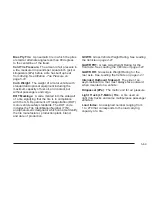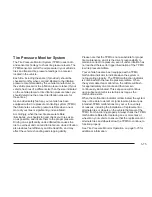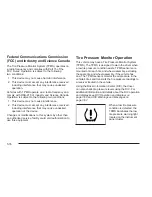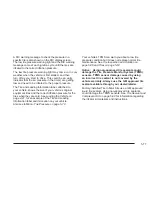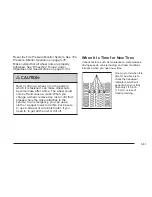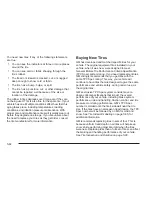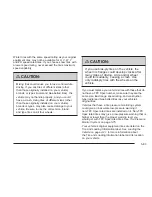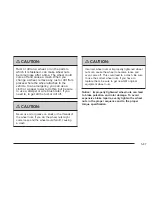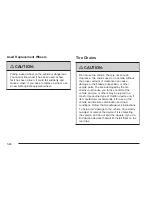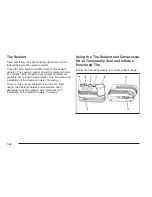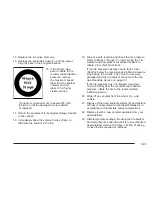
You need new tires if any of the following statements
are true:
•
You can see the indicators at three or more places
around the tire.
•
You can see cord or fabric showing through the
tire’s rubber.
•
The tread or sidewall is cracked, cut, or snagged
deep enough to show cord or fabric.
•
The tire has a bump, bulge, or split.
•
The tire has a puncture, cut, or other damage that
cannot be repaired well because of the size or
location of the damage.
The rubber in tires degrades over time, even if they are
not being used. This is also true for the spare tire, if your
vehicle has one. Multiple conditions affect how fast this
aging takes place, including temperatures, loading
conditions, and inflation pressure maintenance. With
proper care and maintenance tires will typically wear out
before they degrade due to age. If you are unsure about
the need to replace your tires as they get older, consult
the tire manufacturer for more information.
Buying New Tires
GM has developed and matched specific tires for your
vehicle. The original equipment tires installed on your
vehicle, when it was new, were designed to meet
General Motors Tire Performance Criteria Specification
(TPC Spec) system rating. If you need replacement tires,
GM strongly recommends that you get tires with the
same TPC Spec rating. This way, your vehicle will
continue to have tires that are designed to give the same
performance and vehicle safety, during normal use, as
the original tires.
GM’s exclusive TPC Spec system considers over a
dozen critical specifications that impact the overall
performance of your vehicle, including brake system
performance, ride and handling, traction control, and tire
pressure monitoring performance. GM’s TPC Spec
number is molded onto the tire’s sidewall near the tire
size. If the tires have an all-season tread design, the TPC
Spec number will be followed by an MS for mud and
snow. See Tire Sidewall Labeling on page 5-65, for
additional information.
GM recommends replacing tires in sets of four. This is
because uniform tread depth on all tires will help keep
your vehicle performing most like it did when the tires
were new. Replacing less than a full set of tires can affect
the braking and handling performance of your vehicle.
See Tire Inspection and Rotation on page 5-80.
5-82
Содержание 2009 CTS
Страница 6: ...NOTES vi...
Страница 146: ...NOTES 2 68...
Страница 149: ...NOTES 3 3...
Страница 150: ...Instrument Panel Overview CTS Shown CTS V Similar 3 4...
Страница 178: ...United States V Series Automatic Transmission Cluster shown Manual and Canada similar 3 32...
Страница 322: ...CTS V When you open the hood on the 6 2L Super Charged engine you will see the following 5 16...
Страница 434: ...Relays Usage FUEL PUMP Fuel Pump LCK Lock Relays Usage LT POS LP Left Position Lamp REAR FOG Not Used 5 128...
Страница 457: ...Engine Drive Belt Routing CTS CTS V 6 17...
Страница 459: ...Maintenance Record cont d Date Odometer Reading Serviced By Maintenance Stamp Services Performed 6 19...
Страница 460: ...Maintenance Record cont d Date Odometer Reading Serviced By Maintenance Stamp Services Performed 6 20...


